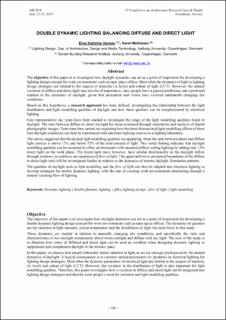Double Dynamic Lighting Balancing Diffuse and Direct Light
| dc.contributor.author | Hansen, Ellen Kathrine | |
| dc.contributor.author | Mathiasen, Nanet | |
| dc.date.accessioned | 2021-12-27T18:46:27Z | |
| dc.date.available | 2021-12-27T18:46:27Z | |
| dc.date.issued | 2021 | |
| dc.identifier.isbn | 978-82-536-1718-3 | |
| dc.identifier.issn | 2387-4295 | |
| dc.identifier.uri | https://hdl.handle.net/11250/2835489 | |
| dc.description.abstract | The objective of this paper is to investigate how daylight dynamics can act as a point of inspiration for developing a lighting design concept for work environments such as open space offices. Most often the dynamics of light in lighting design strategies are limited to the aspects of intensity (lx level) and colour of light (CCT). However, the natural variation of diffuse and direct light may also be of importance, since people have a general preference and a profound relation to the dynamics of daylight, given that perception and vision have evolved underneath changing sky conditions. Based on this hypothesis, a research approach has been defined, investigating the relationship between the light distribution and light modelling qualities of daylight and how these qualities can be complemented by electrical lighting. Four representative sky types have been studied to investigate the range of the light modelling qualities found in daylight. The ratio between diffuse to direct daylight has been examined through simulations and analysis of digital photographic images. Tests were then carried out exploring how the three-dimensional light modelling effects of these four daylight conditions can best be reproduced with electrical lighting sources in a lighting laboratory. The survey suggested that the desired light modelling qualities are appearing, when the ratio between direct and diffuse light sources is above 13% and below 52% of the total amount of light. This initial finding indicates that daylight modelling qualities can be recreated in office environments with standard diffuse ceiling lighting by adding only 13% direct light on the work plane. The direct light must, however, have similar directionality as the daylight inflow through windows, to reinforce an experience of flow of light. The upper and lower perceptual boundaries of the diffuse to direct light ratio will be investigated further in relation to the dynamics of interior daylight illumiation patterns. The qualities of daylight such as light modelling and the flow of light can thus be adapted into electrical lighting to develop strategies for double dynamic lighting, with the aim of creating work environments stimulating through a natural variating flow of lighting. | en_US |
| dc.language.iso | eng | |
| dc.publisher | SINTEF Academic Press | |
| dc.relation.ispartof | ARCH19 June 12–13, 2019 – Trondheim, Norway. Proceedings from the 4th Conference on Architecture Research Care & Health | |
| dc.relation.ispartofseries | SINTEF Proceedings;8 | |
| dc.rights | CC BY 4.0 | |
| dc.rights.uri | https://creativecommons.org/licenses/by/4.0/ | |
| dc.subject | Dynamic lighting | |
| dc.subject | Double dynamic lighting | |
| dc.subject | Office lighting design | |
| dc.subject | Flow of light | |
| dc.subject | Light modelling | |
| dc.title | Double Dynamic Lighting Balancing Diffuse and Direct Light | |
| dc.type | Chapter | |
| dc.type | Peer reviewed | |
| dc.type | Conference object | |
| dc.description.version | publishedVersion | |
| dc.rights.holder | © 2021 The Authors. | |
| dc.subject.nsi | VDP::Medisinske Fag: 700::Helsefag: 800 |
Tilhørende fil(er)
Denne innførselen finnes i følgende samling(er)
-
SINTEF Proceedings [402]

